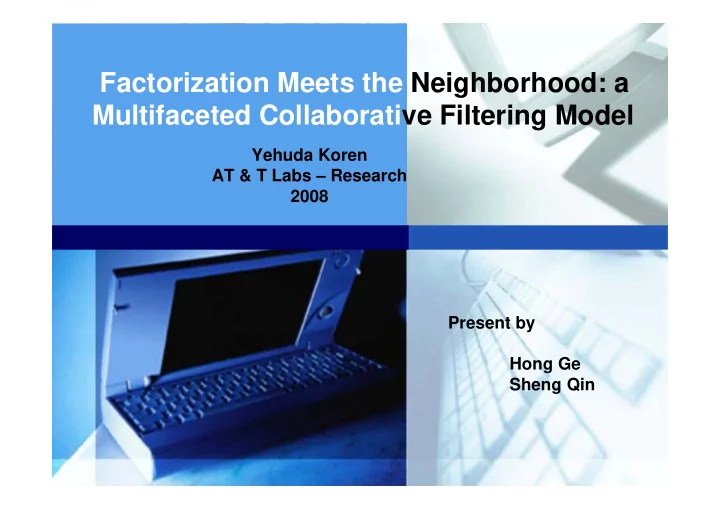

Factorization Meets the Neighborhood: a Multifaceted Collaborative Filtering Model Yehuda Koren AT & T Labs – Research 2008 Present by Hong Ge Sheng Qin
Info about paper & data-set Factorization Meets the Neighborhood: a Multifaceted Collaborative Filtering Model ACM Transactions on Knowledge Discovery from 1 Data (TDD) archive Year of Publication: 2007; cited by 43 times 1 Winner of the $1 Million Netflix Prize (2007)!!!!! 1 •9.34% improvement over the original Cinematch accuracy level Netflix data: 1 •Over 480,000 users, 17,770 movies •Over 1 million observed ratings, 1% in total •Rating: integer from 1 to 5 (with rating time-stamp) •Multivariate, Time-Series
Title interpretation Factorization Meets the Neighborhood: a Multifaceted Collaborative Filtering Model Technique about recommender systems 1 Based on: 1 Collaborative Filtering (CF) •A process often applied to recommender systems Neighborhood Model & Latent Factor Model Using: 1 •Two main disciplines of CF Solution: Some amazing improvement & integration 1 •Innovative point of this paper
Existing methods Neighborhood •Computing relationships between movies, or between users •Not user → movie, but movie → movie
The integrated model W hy integrate?
The integrated model-why? Neighborhood Models Estimate unknown ratings by using known ratings made by user for similar movies Good at capturing localized information Intuitive and simple to implement Latent Factor Models Estimate unknown ratings by uncover latent features that explain known ratings Efficient at capturing global information
The integrated model-why? Reasons: Neighborhood Model: Good at capture localized information Latent Factor Model: Efficient at capturing global information Neither is able to capture all information Complementary with each other. Not account implicit feedback It’s not tried before, why not?
The integrated model-how? How ? Sum the predications of revised Neighborhood Model(NewNgbr) and revised Latent Model (SVD++) Som e details I guess you may want take a nap now. Just joking!
Some background before we go further The Netflix data Ratings Many items in this matrix are missing Need find a good estimate Users for (most of efforts are dealing with this!) Baseline estim ates [Netflix data] is the average rating over all movies indicate the observed deviations of user u and item I, [baseline estimator] respectively, from the average
Neighborhood Model Estim ate by using know n ratings m ade by user for sim ilar m ovies: User specific weights k most similar movies rated by u, also known as Neighbors
Neighborhood models- Revised New Neighborhood m odel: introduce implicit feedback effect use global rather than user-specific weights New predicting rule: h
Latent Models Estim ate by uncover latent features that explain observed ratings: are user-factors vector and item-factors vector respectively
Latent Model- Revised I ntroduce im plicit feedback inform ation Asymmetric-SVD baseline estimate Implicit feedback effect SVD+ + No theoretical explanation, it just works! This model will be integrated with Neighborhood Model
The integrated model How w ell does it w ork? Here is the result.
Test (Instructions) Measured by Root Mean Square Error (RMSE) Abbreviation instructions Integrated ★ Proposed Integrated Model SVD+ + ★ Proposed improved Latent Factor SVD Common Latent Factor New Ngbr ★ Proposed neighborhood, with implicit feedback New Ngbr Proposed neighborhood, without implicit feedback WgtNgbr improved neighborhood of the same user CorNgbr Popular neighborhood method
Experimental results —— RMSE RMSE Latent group Neighborhood group
Time cost NewNeighborhood Time*(min) 10 27 58 Neighbors 250 500 Infinity Precision 0.9014 -0.0010 -0.0004 SVD++ Time*(min) -- -- -- Factors 50 100 200 Precision 0.8952 -0.0028 -0.0013 Integrated Time(min) 17 20 25 Neighbors 300 300 300 Factors 50 100 200 Precision 0.8877 -0.0007 -0.0002
Experimental results —— top K Y axis: Probability distribution of the observed best movie returned 0%~2% X axis: Threshold of return in percentile
prize Integrate
Hard to beat, but… Ignored time-stamps 1 •Time-stamps available (from 1998 to 2005) •Temporal dynamics matters Example 1 6 years later… Action Romance
Hard to beat, but… Ignored time-stamps 1 •Time-stamps available (from 1998 to 2005) •Temporal dynamics matters Example 2 2 5 4 3 5 3 5 5 3 5 2 days later… 4 5
Hard to beat, but… Temporal dynamics are too personal 1 •Represented in author’s latest publication, with comparison •May move the model towards local level
References Yehuda Koren, Factorization meets the neighborhood: a multifaceted collaborative filtering model, in Proceeding of the 14th ACM SIGKDD international conference on Knowledge discovery and data mining (Las Vegas, Nevada, USA: ACM, 2008), 426-434 Yehuda Koren, The BellKor Solution to the Netflix Grand Prize, August 2009
Questions?
Recommend
More recommend